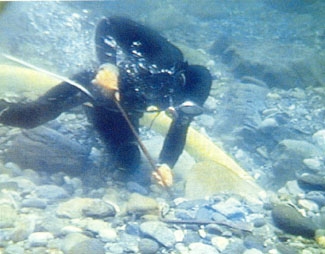By Dave McCracken
Part Two – Sampling For Paystreaks

There are few things in the world more enjoyable — and more exciting — than finding your own pay-streaks, particularly when they are rich! It is one thing if someone else turns you onto a previously-located deposit — which, by the way, you should always take when it is offered to you. It is much more emotionally satisfying when you locate a rich deposit by following the signs discovered by your own sampling program. Seeing the first flakes of gold uncovered, when you knew they were going to be there even before you saw them, is a wonderful feeling; it is a true thrill to follow those flakes into a rich deposit. There is nothing else like it! Some say there is no cure for gold fever.
The procedure for finding pay-streaks is quite simple, really. The key is having the emotional fortitude to follow through with your sampling procedure, by following up on positive signs if they are there. And remember, you don’t need to find a pay-streak in every sample hole. Otherwise, sampling would not be necessary. You only need to find a pay-streak once in a while to make mining pay off — on any scale.
As we discussed in part one, pay-streaks form in those sections of a riverbed where the water force slows down on a large scale during major flood storms. Because gold is so much heavier than other average streambed material in the river, particles, flakes and nuggets of gold tend to collect in these large, slower-moving sections of river, while the lighter materials continue to be washed downstream.
Pay-streaks can be large or small, depending upon the size of the low pressure (low velocity) area in the river and depending upon how much gold traveled through each particular area during major flood storms.
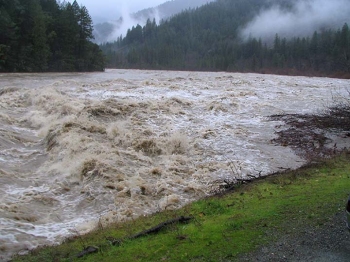
Here is a location on our mining property at K-15A during the 1997 flood
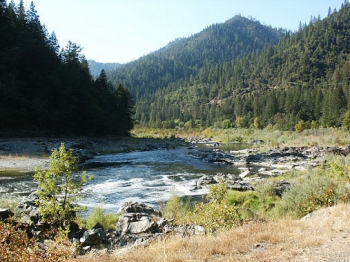
Here is the very same location at K-15A during normal summer flows.
Pay-streaks are very important to miners because they are larger than single-type deposits, such as those found in a bedrock crevice along the gold path. Therefore, pay-streaks are easier to find. Because they tend to be long and wide, pay-streaks are deposits which can be worked usually for quite some time.
Gold can be recovered from a pay-streak which is located on bedrock; it can also be found throughout the streambed material or on the top of a flood layer.
It is important to understand what flood layers are. They are separate strata of streambed, which were laid down by different storms or perhaps at different periods during the same storm. The various layers are usually very easy to distinguish from one other. Each has different colors and consistency, and the gravels are usually of different compact hardness. If you are looking for it, you can nearly always see the changes in flood layers as you dig or dredge a sample hole deeper into the streambed. Sometimes there is only one layer over the bedrock. Often there are two or more layers.
As we discussed in part one, gold is extremely heavy. Therefore, most gold travels along the bottom of the other suspended streambed material as it is being washed downriver during a major flood storm. If the material is washing down across bedrock, then gold can become trapped in the various irregularities, cracks and holes. Sometimes, if conditions allow, gold may even be deposited on top of smooth bedrock to form a pay-streak in a low pressure area of the river.
Sometimes, because the flood storm is not quite extreme enough to break up pre-existing hard-packed streambeds, material moving during a storm will wash over the top of already-established streambed layers, rather than across the bedrock. Therefore, newly-formed pay-streaks may be found on top of pre-existing streambed layers, rather than on bedrock.
It is very common to find pay-streaks on top of a streambed layer. Sometimes you can find pay-streaks on top of several different layers in the same location. Sometimes, you can find pay-streaks on a layer, but not on the bedrock in the same location.
Most gold-bearing rivers have some amount of gold disbursed throughout the streambed material, so you tend to recover a small amount of gold out of each sample hole. We call this “traces.” This usually is not very much gold; not enough to get very excited about and not enough to support a small-scale mining operation. It only takes a few sample holes to give you an idea of the average amount of gold that is disbursed in the general streambed. You can pretty-much expect to get this small amount of gold from each sample hole that you dredge or dig. If you recover more gold from a sample hole than is showing up in the average streambed, it is important to realize you are onto something — even if it is not exciting, yet.
Remember, sampling is the business of following positive signs into a pay-streak. When you are finding increased amounts of gold in an area, it is likely that you are onto the general gold path, and you are into a low pressure area of some magnitude. You may be very close to an excellent deposit.
So the first thing to do, once you start finding increased amounts of gold in a sample hole, is figure out exactly where it is coming from. Is it coming from a layer? This is really important to know.
Several years ago, I had a friend who was recovering two pennyweights (1/10th of an ounce) of gold per day with a 4-inch dredge, dredging in four feet of streambed material. He had been trained in the old school of thought, which says you always dredge to bedrock, no matter what. I jumped into his hole one day and noticed almost immediately that a lot of his gold was coming off the top of a flood layer which was located about six inches beneath the material’s surface. Investigating further, I found there was some gold coming off the bedrock, but it was not very much. About 95% of his gold was coming off that layer. Once I pointed it out, he began to just skim off the top foot of material, and he started recovering about five times as much gold. This is why it is important it is to establish exactly where the gold is coming from in a sample hole!
If you dig a sample hole through deep material and only find a marginal amount of gold, the location might still be worth working if you discover that the gold is coming from a layer change closer to the surface.
When I am dredging a sample hole and see a change in layers, I always slow down and uncover a section off the top of the new layer while careful1y looking for gold. If there is a substantial amount of gold on the layer, it is never hard to see if you are looking for it. All you have to do is hold the suction nozzle further away from the streambed material so there is just enough suction to pull the gravel, but not enough to pull the gold, which is about six times heavier. Underwater magnification makes the gold very easy to see. But you have to be looking for these changes in layers, and you need to slow down and look on top of them as they are being uncovered.
The gold is more difficult to see if you are digging up on the bank. In this case, layer changes can be sampled separately with the use of your gold pan or other recovery equipment.
- Here is where you can buy Prospecting Equipment & Supplies.
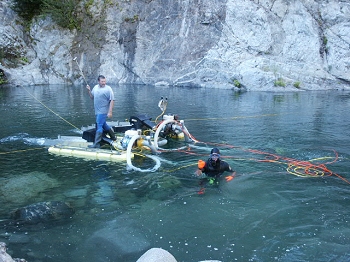 Seeing an increase in the amount of gold in a sample hole, even if it is just a small increase, is one of the most important signs to recognize in sampling. You would not see the increase if you were not on the general gold path and on or near a low pressure location in the river. Seeing an increase in gold is always reason to investigate that location further, either by spreading the hole in different directions to see if it gets better, or by digging or dredging more sample holes in the immediate area. You should be acting like a dog who has found a nice, juicy scent!
Seeing an increase in the amount of gold in a sample hole, even if it is just a small increase, is one of the most important signs to recognize in sampling. You would not see the increase if you were not on the general gold path and on or near a low pressure location in the river. Seeing an increase in gold is always reason to investigate that location further, either by spreading the hole in different directions to see if it gets better, or by digging or dredging more sample holes in the immediate area. You should be acting like a dog who has found a nice, juicy scent!
As mentioned in part one, one of the biggest barriers new miners need to overcome is their own doubtful thoughts about how much gold they are not going to find in a sampling location. Many beginners have themselves talked out of finishing a sampling project long before they have properly completed it! Forget what you think might not be there, and just work hard to see what actually is there. This is what sampling is all about!
Time and time again, I have seen beginning miners start a sampling project, start recovering some gold which is not enough for their minimum requirements, but is far greater than the average amount of gold in the river; and then give the area up because it is not good enough. Afterwards, someone else will open up the same location a little more and find a rich pay-streak. Yet, the original miners are still sampling elsewhere, not having found a pay-streak of their own. Short of finding an acceptable pay-streak, a visible increase in the amount of gold recovered from a sample hole is the best sign you can look for. Don’t walk away from it until you are more than certain it is just a low-grade pay-streak which you have no interest in.
There is something mystical in the way gold affects people. This has been known for a long time. How much gold a person is finding, or not finding, definitely affects his or her emotions. Successful miners have learned to set the negative emotional impact aside and to use effective sampling techniques and hard work instead.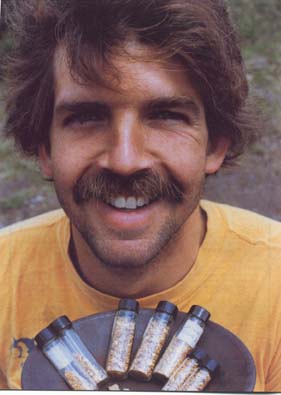
It has been well proven throughout history that gold is much easier to lose than it is to find. And, no doubt, men have walked away from more gold deposits than they have found due to the way they were emotionally affected by the results of their sampling operations.
I know of one man who dredged a sample hole and was recovering four-to-five pennyweights of gold per day. He spent a day pushing the hole towards the bank and discovered that someone had been there with a dredge ahead of him. He spent a day pushing the hole to the right and found the bedrock going deeper, but the gold was getting a little better and the pieces bigger. He decided the area was too difficult and not paying well enough, and went to sample elsewhere before he even came close to defining what kind of pay-streak he had located. What causes a person to give up so easily when the signs are so good? Why walk away from a location with fantastic signs to go sample a new location where you have not yet discovered any positive signs? The answer has to do with the way gold affects people’s emotions, and the fact that it is much easier to lose than it is to find!
There is an excellent lesson to learn from this: Watch for an increase in the amount of gold in your sample holes. Leave your negative emotions out of it. Follow up positive signs when you see them — always. Have some patience, and positive signs will lead you into the pay-streaks.
- Here is where you can buy a sample of natural gold.
- Here is where you can buy Gold Prospecting Equipment & Supplies.
- More About Gold Prospecting
- More Gold Mining Adventures
- Schedule of Events
- Best-selling Books & DVD’s on this Subject


